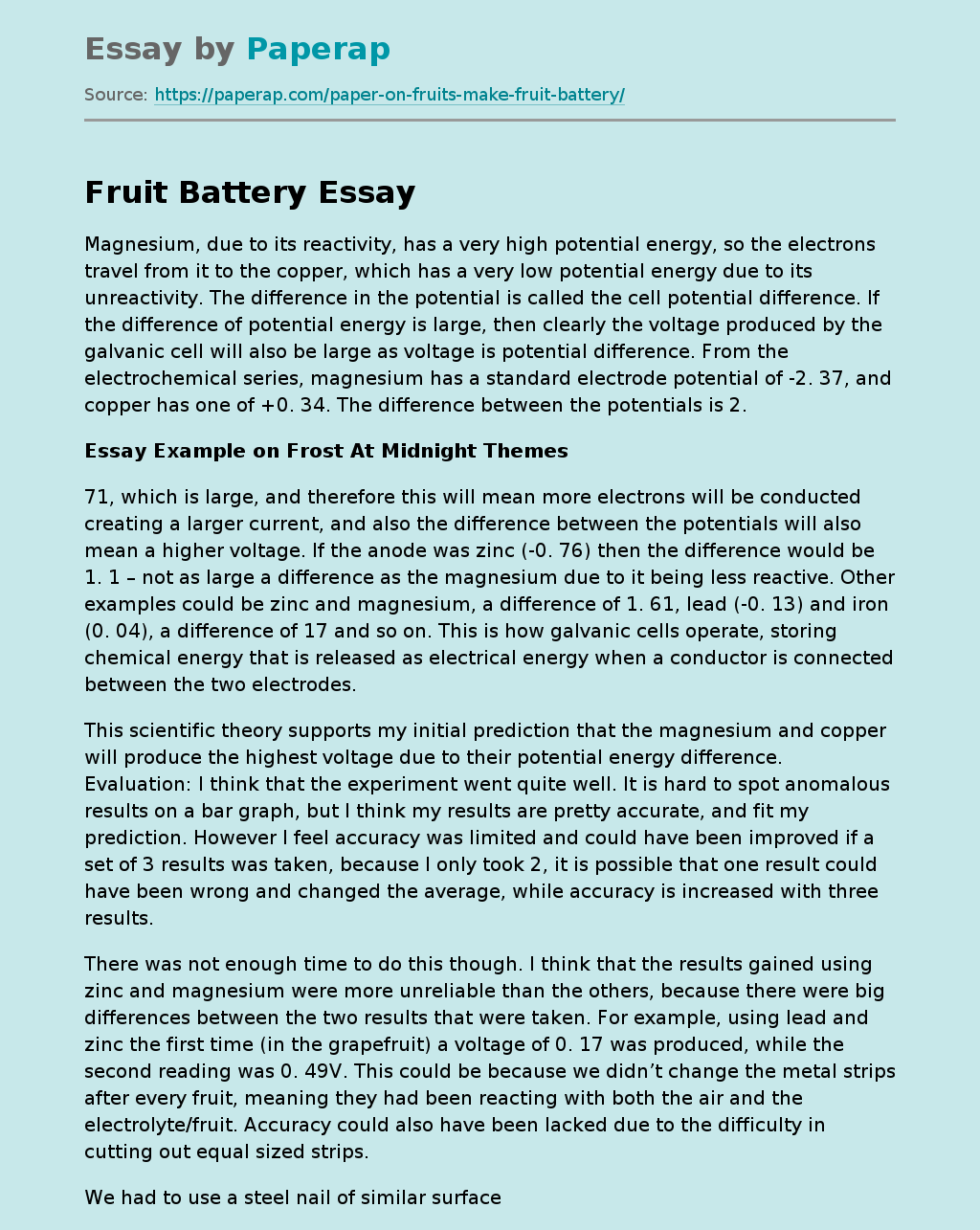Magnesium and Copper's Potential Energy Difference
Magnesium, due to its reactivity, has a very high potential energy, so the electrons travel from it to the copper, which has a very low potential energy due to its unreactivity. The difference in the potential is called the cell potential difference. If the difference of potential energy is large, then clearly the voltage produced by the galvanic cell will also be large as voltage is potential difference. From the electrochemical series, magnesium has a standard electrode potential of -2. 37, and copper has one of +0.
34. The difference between the potentials is 2.
Essay Example on Frost At Midnight Themes
71, which is large, and therefore this will mean more electrons will be conducted creating a larger current, and also the difference between the potentials will also mean a higher voltage. If the anode was zinc (-0. 76) then the difference would be 1. 1 – not as large a difference as the magnesium due to it being less reactive. Other examples could be zinc and magnesium, a difference of 1.
61, lead (-0. 13) and iron (0. 04), a difference of 17 and so on. This is how galvanic cells operate, storing chemical energy that is released as electrical energy when a conductor is connected between the two electrodes.
This scientific theory supports my initial prediction that the magnesium and copper will produce the highest voltage due to their potential energy difference. Evaluation: I think that the experiment went quite well. It is hard to spot anomalous results on a bar graph, but I think my results are pretty accurate, and fit my prediction.
However I feel accuracy was limited and could have been improved if a set of 3 results was taken, because I only took 2, it is possible that one result could have been wrong and changed the average, while accuracy is increased with three results.
There was not enough time to do this though. I think that the results gained using zinc and magnesium were more unreliable than the others, because there were big differences between the two results that were taken. For example, using lead and zinc the first time (in the grapefruit) a voltage of 0. 17 was produced, while the second reading was 0. 49V. This could be because we didn’t change the metal strips after every fruit, meaning they had been reacting with both the air and the electrolyte/fruit. Accuracy could also have been lacked due to the difficulty in cutting out equal sized strips.
We had to use a steel nail of similar surface area because iron foil was unavailable. Fruits are also very unpredictable and vary. I think that we should have perhaps focused on one fruit, like the lemon, and used three different lemons to increase accuracy. This would perhaps be a more useful approach. I believe further investigations are needed to help fulfill the aim of the experiment. I think that acids and alkaline solutions should be used instead of fruits due to their unreliability. This will make the experiment quicker too.
The outcome would be more predictable. The distance between the two metals in the fruit could be varied in further work to again test the voltages produced using different combinations of magnesium, iron, zinc, lead and copper. You could start them with a centimetre difference between them, and then increase this by a cm until it reaches 5 cm. A variety of fruits could again be used as a variable in this method. Other variables to be tested are the surface area of the metals and how that would affect the voltage produced, as it clearly seemed to affect my results.
Magnesium and Copper's Potential Energy Difference. (2019, Nov 27). Retrieved from https://paperap.com/paper-on-fruits-make-fruit-battery/

